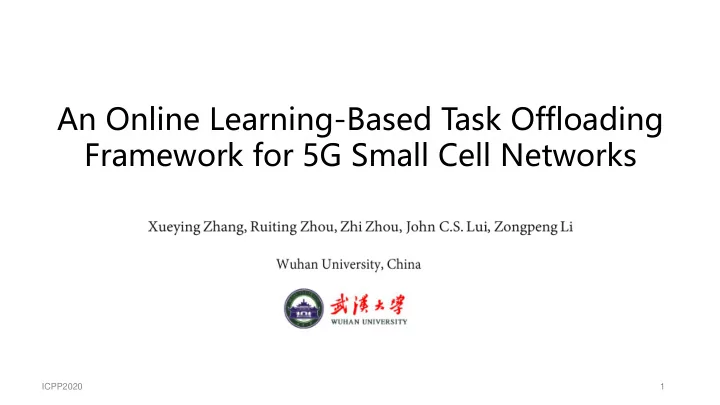

An Online Learning-Based Task Offloading Framework for 5G Small Cell Networks ICPP2020 1
Background & Motivation System Model Outline Algorithm Design Analysis & Performance Conclusion ICPP2020 2
Background & Motivation - 5G 5G technology: the fifth-generation mobile communication technology Higher transmission rate • Faster speed • Larger number of connections • ICPP2020 3
Background & Motivation - small cell node Small cell node (SCN): fundamental element of 5G network Low-power, short-range • Cover small geographical areas • Millimeter-Wave • Closer to wireless devices • Process larger amount of data at faster speeds ICPP2020 4
Background & Motivation - small cell network SCN Improve coverage and capacity • Better and faster connectivity • Macrocell Wide coverage • Further away from the users • Communicate with SCNs • Fig. An illustration of small cell network ICPP2020 5
Background & Motivation 5G boosts demand for new services Characteristic of services Security surveillance Huge amount of data • • Virtual reality Delay sensitive • • Automatic driving High computing requirements • • ……. • Small cells equipped with edge servers represent a competitive solution for mobile task offloading ICPP2020 6
Background & Motivation Features of offloading tasks from wireless devices (WDs) in small cell network Limited connections • Finite computation resources • Significant uncertainties in the task offloading process, such as blockage • A fundamental problem Given limited computation and communication resources, how to select computing tasks to maximize effective reward? ICPP2020 7
Background & Motivation System Model Outline Algorithm Design Analysis & Performance Conclusion ICPP2020 8
System Model - overview MBS: Controls and prioritizes offloading • task to SCNs SCN : 𝑁 SCNs • Limited coverage • Equipped with computing server • Task : Provide task context information • May be covered by multiple small • cells ICPP2020 9
System Model - goal Random process in task offloading: • Reward for SCN 𝑛 to complete task 𝑗 at time 𝑢 𝑉 𝑛, 𝜚 𝑗 , 𝑢 Likelihood for SCN 𝑛 to complete 𝑗 at time 𝑢 • 𝑊(𝑛, 𝜚 𝑗 , 𝑢) Resource consumption 𝑅(𝑛, 𝜚 𝑗 , 𝑢) • Our goal: Compound reward: the effective reward per unit resource for SCN 𝑛 to • complete the task with context 𝜚 at time 𝑢 𝐻 𝑛, 𝜚 𝑗 , 𝑢 = 𝑉 ∗ 𝑊/𝑅 Maximize the total compound reward under system constraints • ICPP2020 10
System Model - constraints The number of tasks accepted by each SCN does not exceed its • communication capacity Each task is not repetitively offloaded by multiple SCNs • Number of successfully processed tasks by each SCN at a time slot • Resource capacity • ICPP2020 11
Background & Motivation System Model Outline Algorithm Design Analysis & Performance Conclusion ICPP2020 12
Algorithm Design - difficulties 1. Uncertain and stochastic environment: reward, likelihood, resource consumption 2. The balance between maximizing the total compound reward and satisfying the system constraints 3. Enumerating all possible sets and selecting the optimal one leads to large search space. How to avoid combinatorial explosion? 4. How to guarantee tasks are not repeatedly offloaded? ICPP2020 13
Algorithm Design - technique 1 Multi-armed bandit (MAB) A model for sequential decision problems with • exploration-exploitation tradeoff Some bandit machines ( arms ), and drawing an • arm yields a reward. ICPP2020 14
Algorithm Design - technique 2 Lagrangian multipliers General MAB framework does not consider any constraints • Introduce adjustable Lagrangian multipliers, to balance reward and constraint • violation Construct a new regret function • 1 𝑛, 𝑢 2 + 𝜇 2 𝑛, 𝑢 ∗ 𝑊 2 𝑛, 𝑢 2 𝑍 = 𝑆 𝑛, 𝑢 + 𝜇 1 𝑛, 𝑢 ∗ 𝑊 Oracle total compound reward - our algorithm total compound reward ICPP2020 15
Algorithm Design - technique 3 Tailored Contextual MAB Each task comes with its context • Massive contexts to be learned • Divide task context space into small hypercubes of similar contexts • Maintain a weight for each hypercube, based on the regret 𝑍 • For each SCN, estimate the selection probability of each task • ICPP2020 16
Algorithm Design - technique 4 k1 Weighted bipartite graph 0.7 A task may be covered by multiple SCNs • S1 0.9 k2 Coordinate multiple SCNs for task offloading • 0.6 Construct weighted bipartite graph, based on all • 0.4 tasks’selection probabilities k3 0.7 S2 Greedy manner • 0.8 k4 ICPP2020 17
Algorithm Design - framework ICPP2020 18
Background & Motivation System Model Outline Algorithm Design Analysis & Performance Conclusion ICPP2020 19
Analysis & Performance - theoretical analysis Regret = total reward of oracle – total reward of our algorithm • Violations of system constraints • Regret and violations are all sub-linear with respect to timespan 𝑈 • Converges to the optimal task offloading decisions over time • Asymptotically optimal performance when 𝑈 is sufficiently large • ICPP2020 20
Analysis & Performance - performance Simulation setup 10000 time slots • 30 SCNs connected to a MBS • 35-100 tasks in the coverage area of each SCN • each SCN can simultaneously support up to 20 wireless device • Reward and likelihood are normalized and uniformly distributed in [0, 1] • ICPP2020 21
Analysis & Performance - performance Performance Metrics Cumulative compound reward (violation) • Per-time-slot compound reward (violation) • Performance ratio • = cumulative compound reward / (cumulative violation1 + cumulative violation2) ICPP2020 22
Analysis & Performance - performance Fig1 Fig2 Fig3 Fig4 ICPP2020 23
Background & Motivation System Model Outline Algorithm Design Analysis & Performance Conclusion ICPP2020 24
Conclusion Study task offloading in 5G small cell networks • Propose an online learning-based solution framework • Leverage MAB technique to learn the best selection strategy, while considering • resource capacity constraints and QoS requirement The efficiency is verified by both theoretical analysis and simulation studies • Achieve sub-linear bounds for both regret and violations • ICPP2020 25
Thanks for listening ! ICPP2020 26
Recommend
More recommend